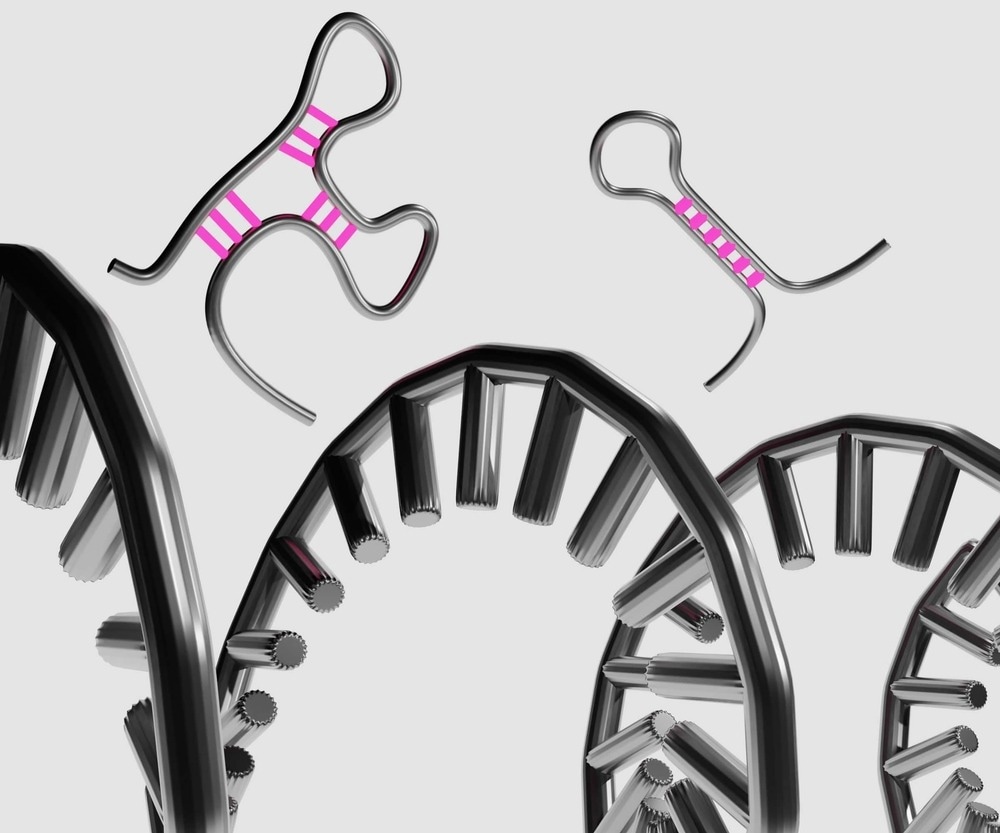MicroRNAs are useful in early cancer diagnosis and prognosis. Hence, developing miniaturized biosensors with high sensitivity for microRNAs is highly desirable. In an article published recently in the journal Analytica Chimica Acta, the researchers constructed a new microfluidic dual-SERS biosensor to detect microRNAs, integrating multifunctional nanosurface immobilized nanoparticles into the system.

Study: A microfluidic-based SERS biosensor with multifunctional nanosurface immobilized nanoparticles for sensitive detection of MicroRNA. Image Credit: Love Employee/Shutterstock.com
The designed nanosurface was composed of porous anodic aluminum oxide (AAO) packed with gold nanoparticles (AuNPs) that served as a good surface enhanced Raman scattering (SERS) substrate. Silver-coated, p-mercaptobenzoic acid surface-decorated ultrasmall gold core-shell NPs (AuMBA@Ag) were used as SERS nanotags. Furthermore, a single standard DNA (ssDNA) was used to capture microRNA and immobilize the nanotags.
The accuracy of the constructed biosensor was improved by subdividing the AAO membrane into AAO/Au array and AAO/Au@Ag array, where the former acted as the primary detector and reactor, and the latter served as a secondary detector and collector. Dual-SERS mode on primary and secondary detectors avoided false positives or false negatives during microRNA detection.
MicroRNA Detection Methods
MicroRNAs are a class of endogenous ssRNAs with 19 to 23 base pairs. These microRNAs modulate the post-transcriptional gene expression in living systems. MicroRNAs are vital for various biological processes such as repression, immune cell/system development, human tumor cell expression, and apoptosis.
The expression of microRNA provides vital information for the early detection of cancer. Nevertheless, the sensitive detection of microRNA is challenging due to its small size, sequence homology among family members, and low abundance in samples. Hence, developing a microRNA detection technique with high specificity, sensitivity, and stability is particularly important.
Northern blotting, polymerase chain reaction (PCR), and microarray methods are conventional technologies used to detect microRNA. However, their detection ability is limited to tissues and is unsuitable for body fluids. Most recent approaches for microRNA detection include colorimetry, fluorescence, electro-chemiluminescence, and SERS.
SERS is a robust analytical method often applied in biomarker detection. Its low background noise, anti-interference, and high sensitivity make it a suitable technique for complicated environments. The major challenge in developing a highly efficient SERS approach for detecting biomolecular targets is to prepare SERS active substrate with good reproducibility and multi-level electromagnetic hot spots.
AAOs are highly ordered and easily controlled nanostructures with tunable geometry that are ideal nanotemplates to prepare SERS substrate. The three-dimensional (3D) structure of AAO and its highly ordered porous nanostructure form a SERS active substrate with multi-level electromagnetic hot spots and good reproducibility.
Duplex-specific nuclease (DSN)-assisted target recycle amplification is a convenient strategy for sensitive detection of microRNA due to its ability to cleave double-stranded (ds) DNA or DNA/RNA heteroduplexes. Previously used microRNA detection strategies via signal amplification had high specificity, low detection limit, and a wide linear range.
Microfluidic-based SERS Biosensor for Detection of MicroRNA
In the present study, AuNP-coated, highly ordered porous AAO (AAO/Au) was used as a DSN-assisted target recycle amplification reactor that served as a primary detector for microRNA-sensitive detection.
The AAO array chamber, coated with Au@Ag NPs, resulted in AAO/Au@Ag nanoplatforms, which were utilized to detect the SERS nanotags in their dissociated forms, released from the reactor, thereby indirectly confirming microRNA concentration. Here, AAO/Au@Ag nanosurface served as a collector and secondary detector.
The presence of microRNA near the nanosurface triggered a hybridization reaction that facilitated the ssDNA to capture the microRNA, forming DNA/microRNA heteroduplexes. Then, the DSN-assisted target recycle process was initiated to cleave the freshly formed DNA/microRNA heteroduplexes into DNA fragments and ss microRNA.
Initially, the SERS nanotags dissociating from the nanosurface resulted in a decreased SERS signal. After capturing the cleaved microRNA, the next cycle of SERS nanotags release was initiated, thus amplifying the detection signal, which correlated to the concentration of microRNA. The microRNA detection was achieved with a sample of 30 microliters and an enzyme of 10 microliters to obtain a wide linear range of concentrations between 10 femtomoles to 10 nanomoles.
The microfluidic dual-SERS detection strategy has a single detection mode that reduces the possibility of false-positive or negative and allows the simultaneous detection of multiple microRNAs via integrating different probes.
Conclusion
In summary, a microfluidic-based biosensor with a dual-SERS detection mode consisting a DSN-assisted target recycle amplification strategy and functionalized AAO substrate was built to detect microRNA in samples. In the construction of this biosensor, the functionalized AAO substrate was divided into two zones.
One zone with an AuNP-loaded AAO array with AuMBA@Ag SERS nanotags was used for the DSN-assisted target recycle amplification process. The other zone with Au@Ag NP-decorated AAO array was used to collect and detect the disassociated SERS nanotags, thus indirectly achieving microRNA detection in the sample. Monitoring SERS signal in two different functional zones correlated to microRNA concentration.
Reference
Ma, W., Liu, L., Zhang, X., Liu, X., Xu, Y., Li, S., Zeng, M. A microfluidic-based SERS biosensor with multifunctional nanosurface immobilized nanoparticles for sensitive detection of microRNA. Analytica Chimica Acta. https://doi.org/10.1016/j.aca.2022.340139
Disclaimer: The views expressed here are those of the author expressed in their private capacity and do not necessarily represent the views of AZoM.com Limited T/A AZoNetwork the owner and operator of this website. This disclaimer forms part of the Terms and conditions of use of this website.